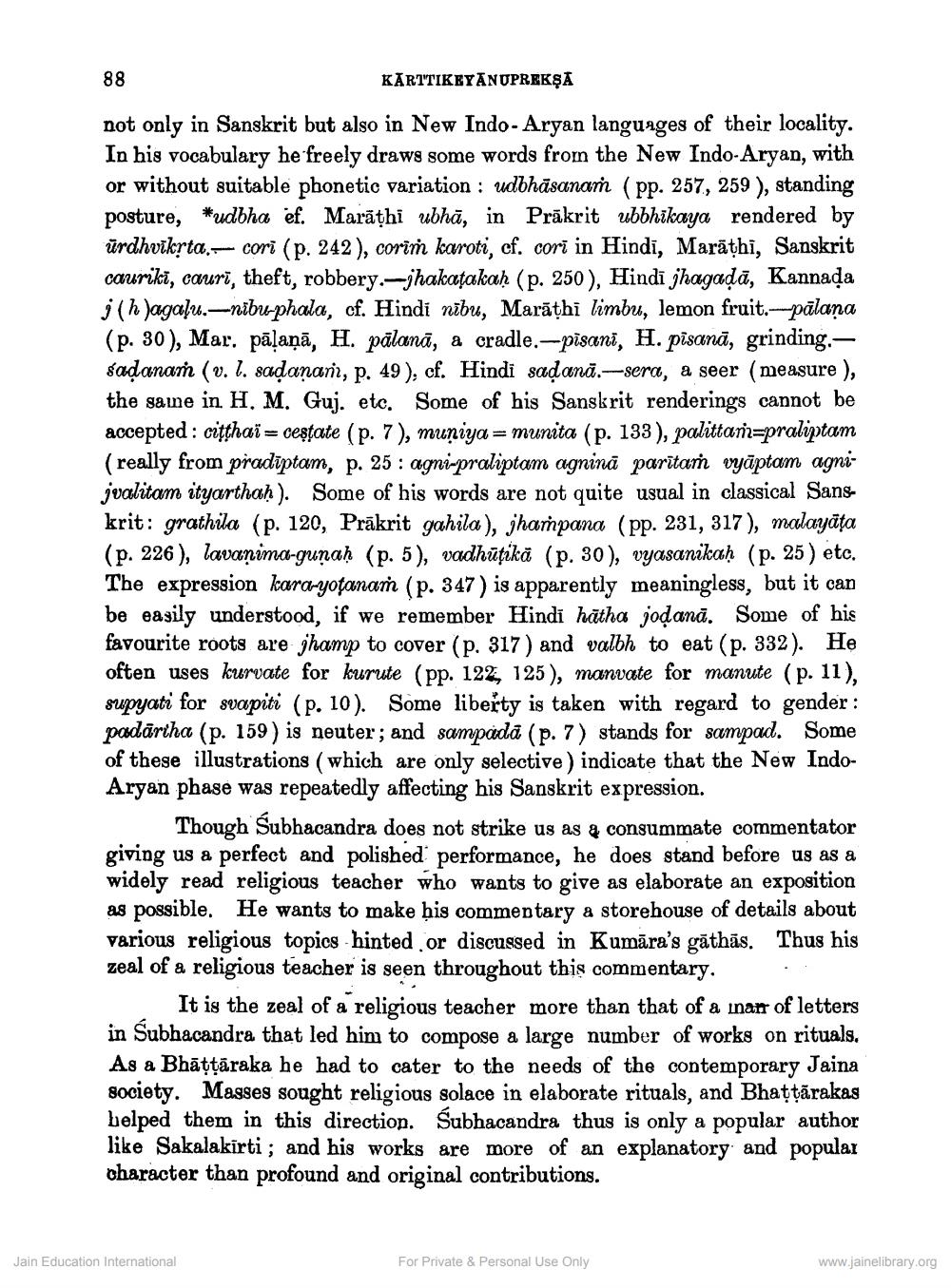________________
88
KĀRTTIKEYANUPREKŞA
not only in Sanskrit but also in New Indo-Aryan languages of their locality. In his vocabulary he freely draws some words from the New Indo-Aryan, with or without suitable phonetic variation : udbhāsanaṁ (pp. 257, 259 ), standing posture, *udbha ef. Marāțhi ubhā, in Prākrit ubbhikaya rendered by ürdhvikyta. cori (p. 242), coriṁ karoti, cf. cori in Hindi, Marāthi, Sanskrit cauriki, cauri, theft, robbery.-jhakatakaḥ (p. 250), Hindī jhagadā, Kannada j(h )agalu.-nibu-phala, cf. Hindi nību, Marāthi limbu, lemon fruit.--pālaņa (p. 30), Mar. pāļaņā, H. pälanā, a cradle.-pisani, H. pisanā, grinding. - sadanam (v. l. sadanar, p. 49), cf. Hindi saçanā.-sera, a seer (measure ), the same in H. M. Guj. etc. Some of his Sanskrit renderings cannot be accepted: citthaï = cestate (p. 7), muniya = munita (p. 133), palittar=praliptam (really from pradiptam, p. 25: agni-praliptam agninā paritar vyāptam agnijvalitam ityarthaḥ). Some of his words are not quite usual in classical Sanskrit: grathila (p. 120, Prākrit gahila), jhampana (pp. 231, 317), malayāta (p. 226), lavanima-gunaḥ (p. 5), vadhūţika (p. 30), vyasanikaḥ (p. 25) etc. The expression kara-yotanam (p. 347) is apparently meaningless, but it can be easily understood, if we remember Hindi hātha jodanā. Some of his favourite roots are jhamp to cover (p. 317 ) and valbh to eat (p. 332). He often uses kurvate for kurute (pp. 122, 125), manvate for manute (p. 11), supyati for svapiti (p. 10). Some liberty is taken with regard to gender : padāriha (p. 159) is neuter; and sampada (p. 7) stands for sampad. Some of these illustrations (which are only selective ) indicate that the New IndoAryan phase was repeatedly affecting his Sanskrit expression.
Though Subhacandra does not strike us as a consummate commentator giving us a perfect and polished performance, he does stand before us as a widely read religious teacher who wants to give as elaborate an exposition as possible. He wants to make his commentary a storehouse of details about various religious topics hinted or discussed in Kumāra's gāthās. Thus his zeal of a religious teacher is seen throughout this commentary,
It is the zeal of a religious teacher more than that of a inan of letters in Subhacandra that led him to compose a large number of works on rituals. As a Bhāțțāraka he had to cater to the needs of the contemporary Jaina society. Masses sought religious solace in elaborate rituals, and Bhattārakas belped them in this direction. Subhacandra thus is only a popular author like Sakalakirti ; and his works are more of an explanatory and popular character than profound and original contributions.
Jain Education International
For Private & Personal Use Only
www.jainelibrary.org




